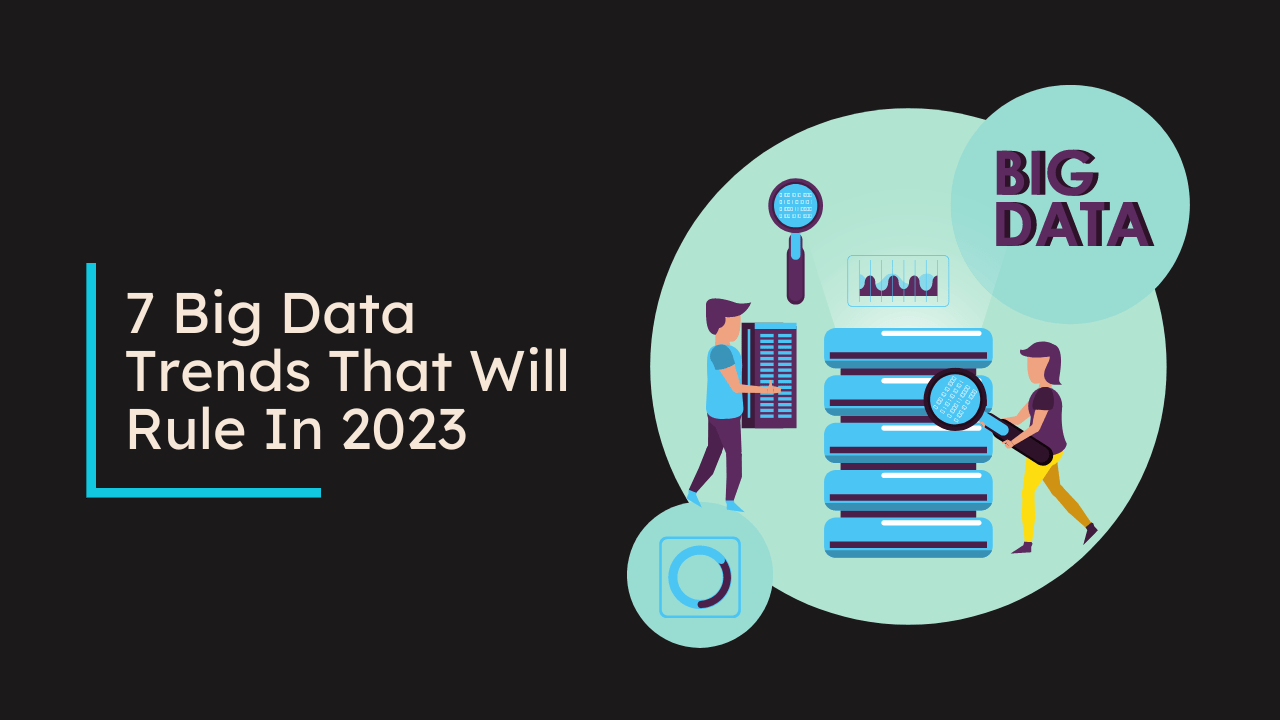A single internet user produced approximately 146,880 MB of data every day. This data will accumulate to nearly 94 zettabytes by the end of this year. What’s more surprising is that if internet use remains consistent (which is likely to be the scenario), the data volume will touch the mark of 149 zettabytes by 2025.
This will certainly help businesses learn about their target audience and provide them with better-quality products and services. However, the use of big data is not limited to customer experience and service.
It aids the evolution of cloud software- helping Latin American organizations track and analyze the company’s data in real-time. Hence, they can make appropriate modifications to their prevailing working practices.
Moreover, as different industries are gradually adopting AI and ML, learning about the big data trends for the upcoming years has become the need of the hour. It will assist the entrepreneurs in drafting plans in the current landscape while keeping the big picture of BDA (Big Data and Analytics) in mind.
So, let’s begin.
1. Natural Language Processing
AI, the Internet of Things (IoT), big data, and machine learning facilitate technology and human interaction. And the major role in its success is played by Natural Language Processing (NLP). It allows humans to interact with the smart systems in human language. You can take the example of voice assistant programs and devices for better understanding.
It assists the user in availing the high-quality information without indulging in exotic codes or keywords.
For businesses, NLP aids with sentiment analysis. Simply put, it provides insights into how customers honestly feel about the brand at different parameters. These can range from income, location, education demographics, and more.
Nevertheless, to use NLP to its full potential, businesses need to deploy their best resources. That means they need a separate team of qualified data engineers to streamline the process of the data pipeline, mining, lakes, and automated reports.
Now, there are two ways to attain this task. First, to recruit new data engineers and analytics and set up an entire system. This time-consuming process may affect your budget if you are a small enterprise.
Second, you can outsource a Latam software development company and use its resources for your company’s benefit. It will help save money while integrating the company data to get valuable insights. Not to mention, outsourcing enables you to utilize the company resources to the best of your ability and gain a competitive advantage.
2. Revolution of DaaS
You might have already heard or learned about SaaS (Software-as-a-Service), which is associated with delivering applications (services) to the end-users on demand. All your email services to video streaming platforms are a part of SaaS.
Likewise, businesses are now utilizing DaaS (Data-as-a-Service) to their advantage. It is an information supply and distribution model that works on the cloud. Ironically, DaaS is not a new concept.
According to statistics, the global DaaS market size was 43.06 billion in 2021 and is expected to reach the mark of 455 billion by 2030. The estimated compound annual growth rate is 39.40% (2020-2030).
A few real-life instances where you will likely encounter Data-as-a service are purchased music, image files, and videos from online sources. Nevertheless, the product catalog, map data, and financial data services have given a new shape to this service.
The best part is that data is kept well-secured throughout the collection and distribution process. Businesses can further outsource their data to others and assist in better customer understanding and service delivery.
Tip: By integrating SaaS and DaaS, a company can easily gain a competitive advantage.
3. Aids Climate Change Research
The debates on climate change are often heated and never-ending. However, using big data, renowned organizations such as The Intergovernmental Panel on Climate Change (IPCC) can resolve the constant arguments. They can further encourage different countries to work together for a common cause.
It is because climate change research is supported by factual information- free from human biases. It will facilitate the implementation of data-driven and climate-conscious decisions to save the planet and create a common ground.
As carbon emission is reported to be the root cause of ozone depletion, research centers, as well as businesses, can use the collected insights to lower carbon footprints. Of course, it is easier said than done. However, the first step to streamlining climate change research has been initiated thanks to big data.
Are You Wondering?
Why should businesses care about climate change?
Taking into consideration the prevailing conditions- drained resources, rising population (8 billion for now), poor food quality, submerged oceans, and more, businesses are left with no choice but to implement eco-friendly practices immediately. For this, they need accurate reports about climate change.
4. Facilitates Data Governance Initiatives
Did you know that 70% of businesses failed to fulfill customers’ requests for “copy of personal data records”? This request was a part of the General Data Protection Regulation (GDPR) regulations. Consequently, businesses had to pay fines and other penalties.
Since then, data governance initiatives have continued to mobilize globally. All business sectors that work with big data are now subjected to more consistent compliance.
This accelerates customer trust in the brands as well as facilitates online payment transactions. Of course, the pandemic has played its fair share in hastening these initiatives, providing power to the customers.
Simply put, customers can now restrict the data, especially from businesses not complying with the GDPR regulations. At the same time, if a company is credible and keeps the customer data safe, they gain trust. It enables them to use the data wisely and for the right purpose.
Table of Contents
5. Need Of Cybersecurity
As the saying goes, “with great power comes great responsibilities.” To leverage big data, it is critical for businesses to take appropriate data safety measures. Moreover, considering the data theft statistics, it has become even more critical to boosting cybersecurity practices.
According to the reports of Statista, the average data breach cost in the US is approximately 9.44 million dollars (as of 2022). Whereas the global average is 4.35 million U.S. dollars.
IBM reports also affirm this information, as a data breach is the most expensive in the United States.
That’s why in the upcoming years, i.e., 2023 and beyond, industries need to look for possible loopholes in their cybersecurity measures and resolve them on an immediate basis. Remember that time is of the essence when dealing with customers’ private data. It would be wise to understand the commonly reported issues as given below and eliminate the risks.
- Limited cloud storage
- Distribute network framework
- Non-relational databases
- Untrained employees
- Social engineering risks
- Security misconfiguration and more
Additionally, businesses, irrespective of their industry or size, should invest in reliable cybersecurity software to cater to their rising needs. All these solutions will ensure that confidential information is protected and customer trust is retained.
6. New Growth Areas
Big-budget companies have already used business intelligence solutions and custom software for their day-to-day operations. This is done by understanding the business requirement and analyzing the collected data to resolve the potential issue.
The frequent updates of these solutions now enable them to scale the old and new customers and reach new heights.
These solutions can streamline regular business operations effortlessly, from advertisement to social media management, supply chain management to customer support.
However, where can you get accurate data that suits your specific organization’s needs? The answer is from data provided by customers via landing page behavior patterns, geographical origins, customer transactions, consumer feedback, and video feed of store branches.
Moreover, you can deploy new analytic tools to gain insights that are not readily available. That, too, as quickly as in real-time.
Perhaps, it won’t be wrong to say that there are numerous ways to collect data for a business. Conditioned, companies must be vigilant about information use and provide only limited access.
7. Facilitating The Field Of Medicine
Businesses are keen to contribute to the welfare of people. Health-related absences, payments, and other work-related concerns become less burdensome when the population is healthy.
The fact that healthcare costs in the US alone currently represent 17.7% of GDP is a concerning statistic (CMS, 2019). Thus, it stands to reason that the medical industry is one of big data’s most popular applications. Plus, its importance will only increase, given the rise of both common and rare human diseases worldwide.
Alas, many scientists believe that by compiling all of the world’s medical histories, medical breakthroughs will happen more quickly and earlier than anticipated. Finding a medium ground between private and public research organizations is difficult because patents are thrown around everywhere and slow down the quest for fresh discoveries.
Clinical record data is expected to reach 170 exabytes in 2019 alone, with an average annual growth rate of 1.2 to 2.4 exabytes. Indeed, it takes some effort to navigate all of those enormous zeroes and ones, but the benefits are well worth it.
To Sum It All Up
The development in the field of Big Data and Analytics is yet to reach its full potential. That means there will be more ways in which different industries and businesses can reap the benefit of the data available and provide engaging experiences to their respective audiences.
Nevertheless, the need for high cybersecurity also prevails along with the new trends and developments. Industries and businesses have to ensure that all the information collected is kept safe and only authorized parties have access to it.

I am a passionate, adventurous, and insatiate learner who loves to write about the latest technology trends. My experience working in an MNC has motivated me to understand that there are certain niche requirements for writing strategically about brands’ messages towards people’s interests which I’ve mastered over time through trial and error of many projects under various clients across diverse industries. It is my honest effort to put my experiences and knowledge of industry towards readers.






